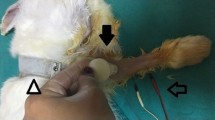Abstract
The purpose of this study was to determine the validity of measuring median nerve distal sensory latency with a portable digital electroneurometer. The results from the digital electroneurometer were compared to standard nerve conduction studies in 51 subjects (40 asymptomatic hands and 12 hands with probable carpal tunnel syndrome). There was a high correlation (r=0.92) between the latencies obtained from the electroneurometer and the onset latencies measured by standard nerve conduction studies. The mean difference between distal sensory latencies for matched pairs of latency measurements was 0.09 (+/−0.21) ms. The use of the digital electroneurometer for obtaining distal sensory latencies proved to be objective and valid. The electroneurometer would be useful in a variety of occupational and clinical settings for screening of peripheral neuropathy where standard nerve conduction equipment may be unavailable or impractical.
Similar content being viewed by others
References
Szabo RM, Gelberman RH. The pathophysiology of nerve entrapment syndromes.J Hand Surg 1987; 12A: 880–884.
Lundbory G, Dahlin LB. The Pathophysiology of Nerve Compression.Hand Clinics 1992; 8: 215–227.
DeKrom MCTFM, Knipschild ADM, Thus CT, Boekkooi PF, Spaans F. Carpal tunnel syndrome: Prevalence in the general population.J Clin Epi 1992; 45: 373–376.
Masear VR, Hayes HM, Hyde AG. An industrial cause of carpal tunnel syndrome.J. Hand Surg 1986; 11A: 222–227.
Katz JN, Larson MG, Sabra A, Krarup C, Stirrat CR, Sethi R, Eaton HM, Fossel AH, Linag MH. The carpal tunnel syndrome: Diagnostic utility of the history and physical examination findings.Ann Intern Med 1990; 113: 321–327.
Katz JN, Stirrat CR. A self-administered hand diagram for the diagnosis of carpal tunnel syndrome.J Hand Surg 1990; 15A: 360–363.
Simpson J. Electrical signs in the diagnosis of carpal tunnel and related syndromes.J Neurol Neurosurg Psychiat 1956; 19: 275–280.
Steven JC. AAEE Minimonograph #26: The electrodiagnosis of carpal tunnel syndrome.Muscle Nerve 1987; 10: 99–133.
Redman MD, Rivner MH. False positive electrodiagnostic tests in carpal tunnel syndrome.Muscle Nerve 1988; 11: 511–518.
Phalen GS. The carpal tunnel syndrome: Seventeen years experience in diagnosis and treatment of 654 hands.J Borne Joint Surg 1966; 48A: 211–219.
Braum RM, Davidson K, Doehr S. Provocative testing in the diagnosis of dynamic carpal tunnel syndrome.J Hand Surg 1989; 14A: 195–197.
Novak CB, MacKinnon SE, Brownlee R, Kelly L. Provocative sensory testing in carpal tunnel syndrome.J Hand Surg 1992; 17B: 204–208.
Bleecker ML, Agnew J. New techniques for the diagnosis of carpal tunnel syndrome.Scand J Work Environ Health 1987; 13: 385–388.
Cook TM, Rosecrance JC, Brokman SJ, Rulon AS, Wise CA. Reliability of a digital electroneurometer for the determination of motor latency of the median nerve.J Occup Rehab 1991; 1: 105–112.
Rosier RN, Blair WF. Preliminary clinical evaluation of the digital electroneurometer.I.S.A. Proceedings, Biomedical Sciences Instrumentation 1984; 20: 55–62.
Osterman AL, Aversa BA, Greenstein D. Use of the Nervepace Electroneurometer as an Effective Screening Tool in the Diagnosis of Carpal Tunnel Syndrome. American Society for Surgery of the Hand, 44th Annual Meeting, Settle, Washington, Scientific Exhibit, September 1989.
Steinberg DR, Gelberman RH, Rydevik B, Lundborg G. The utility of portable nerve conduction testing for patients with carpal tunnel syndrome: A prospective clinical Study.J Hand Surg 1992; 17: 77–81.
Durnil WG, Rosencrance JC, Cook TM, Birgen WS, McMurray SJ, Dostal AB. Reliability of distal sensory latency measures of the median nerve using an electroneurometer.J Occup Rehab 1993; 3: 105–112.
Feirstein MS. The performance and usefulness of nerve conduction studies in the orthopaedic office.Orthop Clin North Am 1988; 19: 859–866.
Grant KA, Congleton JJ, Koppa RJ, Lessard CS, Huchingson DR. Use of motor nerve conduction testing and vibration sensitivity testing as screening tools for carpal tunnel syndrome in industry.J Hand Surg 1992; 17A: 71–6.
Nathan PA, Meadows KD, Doyle LS. Sensory segmental latency values of the median nerve for a population of normal individuals.Arch Phys Med Rehab 1988; 69: 499–501.
Hodgkins ML, Grady D. Carpal tunnel syndrome.West J Med 1988; 148: 217–220.
Author information
Authors and Affiliations
Rights and permissions
About this article
Cite this article
Rosecrance, J.C., Cook, T.M. & Bingham, R.C. Comparison of a digital electroneurometer and standard nerve conduction studies for the measurement of median nerve sensory latency. J Occup Rehab 3, 191–199 (1993). https://doi.org/10.1007/BF01097429
Issue Date:
DOI: https://doi.org/10.1007/BF01097429




